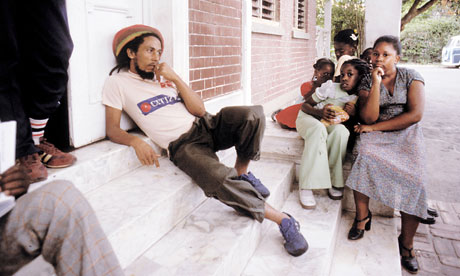
Kevin Macdonald's three fictional movies have taken him to Idi Amin's Uganda, Washington DC and the northern reaches of Roman Britain. They're all thrillers of various kinds, as are Touching the Void and One Day in September, the tightly focused, feature-length documentaries that preceded them. Touching the Void centres on a dangerous expedition by two British climbers in the Peruvian Andes in 1985 and uses interviews with the real participants and simulated scenes played by actors. One Day in September is about the massacre of Israeli athletes by Arab terrorists at the 1972 Olympics and, in addition to interviews and archive footage, employs computer graphics to explain the course of events.
His new film, a cinebiography of Bob Marley is a bigger, baggier and simpler thing. It's the story of a man who lived an extraordinarily full yet oddly mysterious life and died a world figure 30 years ago, shortly after reaching the age of 36. It is, however, told without any reconstructions or impersonations and neither Sidney Poitier nor Morgan Freeman was called in to deliver a rousing commentary explaining the man's contradictions, achievements and significance.
The picture begins in West Africa at an old fortress on the Gold Coast (now Ghana). Through its "Door of No Return" leading to the sea passed many of the millions of shackled slaves who were shipped across the Atlantic. This was the journey made by his ancestors that shaped Marley's life, identity and music and the belief system that drew them together.
He was born in the remote Jamaican village of Nine Mile in 1945 and Macdonald takes us there in a lyrical aerial shot across the steep, wooded hill country. His mother, Cedella, was black and 16. His father, Norval Marley, a white man aged 65, was employed by the forestry commission to prevent the theft of timber. He rode around the countryside like a seigneurial Cossack and styled himself Captain, though there's no evidence he'd held any commissioned rank or served in any war. In the only known photo of Norval, he's on horseback attempting to look authoritative and his family refused to recognise Bob when he once called on them for help.
Macdonald sees Bob as a man who felt rejected by both the black and the white communities, an outsider who was to find a symbolic home in Africa through embracing Rastafarianism, a style of personal independence and social defiance, and a mission to bring people together in a grand international, inter-racial brotherhood.
Marley grew up in extreme poverty, first in the countryside, then in the slums of Kingston's Trenchtown, where the first photograph of him was taken at the age of 12. The documentation of the early life is thin, but Macdonald is able throughout to draw on the colourful testimony of his formidable mother, his friends, fellow musicians, a variety of female companions (Marley had nine or 10 children by six or seven different women) and later some businessmen, politicians and gangsters.
There are splendid anecdotes about survival, about Bob and his band, the Wailers, developing a new kind of music that fused local and international forms into a distinctive form of reggae, and the zig-zagging of a career that took Marley to the United States, where his mother had relocated, to Europe and to Africa. Much of what we hear from Jamaican witnesses is spoken in a beguiling, if sometimes obscure, patois and there are the kind of contradictions in the individual assessments of his character and the accounts of the fraught progress of the Wailers that one would expect. This is Rashomon territory.
But there are compromises and concessions of a different kind that have come about through the need to secure interviews, musical rights and other necessary forms of co-operation. These are reflected in the names of several family members and various close business associates listed in the credits as producers. Some of these people provide the finest testimony. Among them are Bob's Cuban-born wife Rita, who worked in his backing group and recalls seeing stigmata on Haile Selassie's hand during his triumphant visit to Jamaica; Bob's three children by her (Cedella, Ziggy and Stephen); the beautiful, spirited Cindy Breakspeare, his trophy companion and former Miss World who bore him a child but refused to embrace Rastafarianism; and the laidback British impresario Chris Blackwell of Island Records.
If Marley ultimately remains something of a mystery (he gave few interviews and in none was particularly forthcoming), we nevertheless get a vivid impression of a career that included a brief stint on a Chrysler production line in Delaware, a long period of apprenticeship as a composer (initially working with homemade instruments) and a rise to local and international stardom. Gradually, the dreadlocks, the music and the cloud of ganja smoke come together to form as recognisable an image as that of the equally short-lived Che Guevara.
He was, however, altogether less militant than Che, virtually apolitical, which did not prevent competing forces seeking his allegiance or seeing him as a valuable symbol for their causes. In 1976, an assassination attempt in Jamaica drove him into exile. It wasn't, however, a bullet that did for him but the stud of a boot during a game of his beloved football in a London park, triggering the melanoma in his foot that eventually consumed his body.
We hear of a beautiful moment in a wintry Bavarian clinic where Bob's mother read the Book of Job to the emaciated singer, his dreadlocks lost to chemotherapy, shortly before he flew across the Atlantic to die in Miami in May 1981.
Perhaps this impressive, thoughtful portrait should have ended there. Instead, it concludes with a succession of Marley's hits being sung in a various languages by cheerful young people on every continent. That's all a little too "I'd Like to Teach the World to Sing" Coca-Cola-ish for my tastes.

